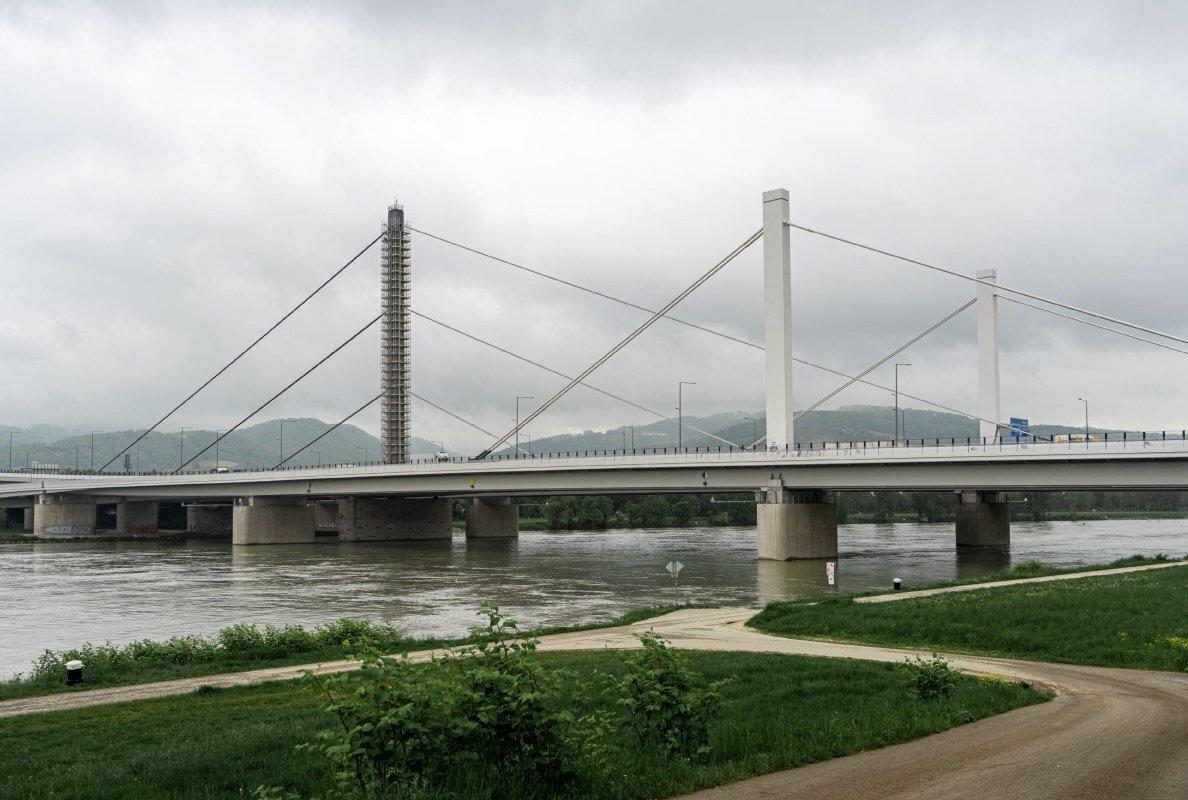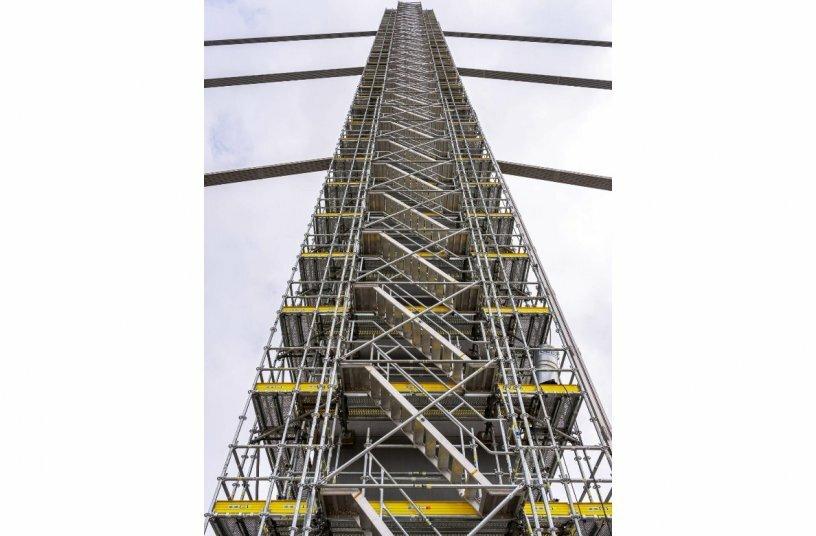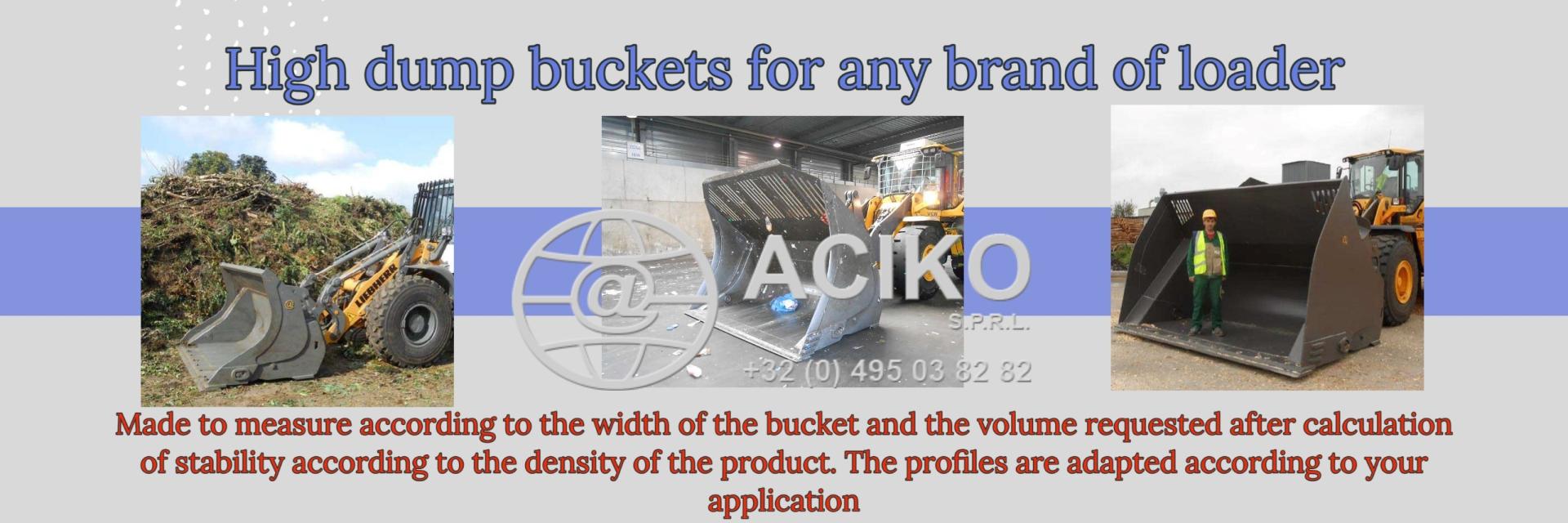R.E.News International-Doka formwork & scaffolding to renovate Voest Bridge
 08/05/24-FR-English-NL-footer
08/05/24-FR-English-NL-footer
Coffrages et échafaudages Doka pour la rénovation du pont Voest

 Ringlock was used to scaffold the 65-metre-high pylon of the Voest Bridge in Austria.
Ringlock was used to scaffold the 65-metre-high pylon of the Voest Bridge in Austria.
IMAGE SOURCE: Doka GmbH-An integrated stairway and connection options for a material lift without direct tension anchoring ensure maximum safety for the construction site team.
IMAGE SOURCE: Doka GmbH
Le système d'échafaudage Ringlock de Doka a joué un rôle crucial dans la rénovation du pont Voest en Autriche, en fournissant une plate-forme de travail sécurisée pour la maintenance sans ancrage sous tension.
Les solutions de coffrage et d'échafaudage de l'entreprise ont fait partie intégrante dès les premières étapes, y compris la création de ponts de contournement temporaires pour minimiser les perturbations dans le centre-ville de Linz.
La collaboration de Doka avec Strabag SE et Pecan GmbH a assuré le succès du projet dans un délai de trois mois, soulignant l'efficacité d'avoir une source unique pour les échafaudages et les coffrages.
Le PDG Robert Hauser souligne l'engagement de Doka en faveur de l'innovation et de la durabilité dans le secteur de la construction, en visant à réduire les émissions de carbone et à soutenir les projets de rénovation.
Doka s'efforce d'atteindre zéro émission nette d'ici 2040 et a introduit des données sur l'empreinte carbone de plus de 7 000 de ses produits, y compris les échafaudages, afin de promouvoir la responsabilité environnementale.
L'accent mis par l'entreprise sur les projets de rénovation en Europe fait partie de sa stratégie visant à soutenir la transition du secteur de la construction vers la réduction des émissions de carbone et la revitalisation des structures existantes.
Doka, leader mondial du coffrage et des échafaudages, ajoute de la valeur aux projets de rénovation en permettant aux entreprises de construction d'appliquer intelligemment son système d'échafaudage Ringlock pour soutenir des projets de rénovation de toutes tailles.
Lors de sa construction en 1972, le pont qui enjambe le Danube était le plus long pont d'Autriche et le premier pont à haubans construit dans le pays. Avec en moyenne plus de 100 000 automobilistes circulant chaque jour sur ce tronçon de l'autoroute A7 Mühlkreis, le pont nécessitait un entretien pour supporter le flux constant de véhicules.
Un élément du projet exigeait que l'entreprise de construction Strabag SE supporte un pylône en acier de 65 mètres de haut sans ancrage sous tension. La solution de Doka a enveloppé le pylône avec un échafaudage Ringlock, fournissant ainsi une plate-forme de travail sûre et sécurisée à tous les niveaux permettant la maintenance sur site de la structure porteuse. Le haut degré de flexibilité offert par Ringlock a facilité la création d'un escalier intégré et d'options de connexion pour permettre l'installation d'un monte-matériaux. Des entretoises de compression en forme d'anneau supportaient la charge et, grâce à la polyvalence du système modulaire éprouvé, l'échafaudage a été facilement adapté pour répondre aux besoins du plan d'étage. Les ouvriers du chantier pouvaient travailler en toute sécurité sachant que le Deutsches Institut für Bautechnik (DIBt) avait certifié le système d'échafaudage. Les services rationalisés de Doka, en collaboration avec Pecan GmbH, l'entrepreneur en échafaudages, ont contribué de manière significative au bon succès du projet dans le délai prévu de trois mois.
Doka a également joué un rôle essentiel dès les premières étapes du projet de rénovation du pont, en fournissant le coffrage pour la création des ponts de contournement temporaires acheminant la circulation vers le centre-ville de Linz, réduisant ainsi les perturbations pour les entreprises qui y opèrent, les résidents et les visiteurs en déplacement. Vers la ville. Pour Strabag et la société d'échafaudages Pecan, disposer d'un point de contact unique pour des échafaudages et des coffrages pratiques, efficaces et fiables, a rationalisé les opérations. Doka a permis de conserver de nombreux composants existants dans la structure du pont, réduisant ainsi le besoin de nouvelles constructions et réduisant ainsi les coûts et les émissions de carbone.
Le partenariat avec Doka a permis de garantir que la rénovation puisse se dérouler en toute sécurité et sans problème, ajoutant ainsi de la valeur au projet et à l'engagement du secteur de la construction en faveur de la réduction des émissions de carbone. Selon le Forum économique mondial, la modernisation et la rénovation des bâtiments et des structures peuvent entraîner une réduction des émissions de carbone de 50 à 75 % par rapport à la construction d'une structure entièrement nouvelle. Doka s'engage en faveur de la réduction des émissions de carbone dans le secteur de la construction et intensifie son soutien aux projets de rénovation.
« L'application réussie de notre système d'échafaudage Ringlock à un projet de rénovation aussi important que le pont Voest démontre notre esprit d'innovation, qui se concentre sur l'augmentation des normes de l'industrie de la construction, l'amélioration de la sécurité et la fourniture de produits qui réduisent l'empreinte carbone de l'industrie », déclare Robert Hauser, PDG. de Doka. « Nous sommes fiers de soutenir des projets de rénovation ainsi que la construction réfléchie de nouvelles structures. »
Doka s'engage à atteindre zéro émission nette d'ici 2040. En mettant l'accent sur la décarbonisation, l'entreprise a déjà calculé l'empreinte carbone de plus de 7 000 de ses produits. Hauser déclare : « Doka s'efforce de soutenir un avenir durable grâce à la transparence environnementale. Début 2024, nous avons introduit les données sur l'empreinte carbone de nos produits d'échafaudage, marquant une nouvelle étape dans notre portefeuille de coffrages. Nous sommes fiers d'être les premiers dans notre secteur à le faire. » Doka propose ainsi des données transparentes sur les émissions de GES, permettant ainsi aux clients de prendre des décisions d'achat respectueuses de l'environnement dans les projets de rénovation et de réaménagement.
« Nous pensons que les projets de rénovation représenteront une part croissante de notre activité en Europe et nous sommes impatients de travailler avec des entreprises de construction pour rajeunir les bâtiments anciens, revitaliser les structures existantes et réparer les structures civiles qui relient les communautés, tout comme le pont de Voest en Autriche. » , conclut Hauser.
NJC.© Info Doka GmbH
------------------------------------------------------------------------------------------------------------------
 08/05/24-English
08/05/24-English
Doka formwork & scaffolding to renovate Voest Bridge

 Ringlock was used to scaffold the 65-metre-high pylon of the Voest Bridge in Austria.
Ringlock was used to scaffold the 65-metre-high pylon of the Voest Bridge in Austria.
IMAGE SOURCE: Doka GmbH-An integrated stairway and connection options for a material lift without direct tension anchoring ensure maximum safety for the construction site team.
IMAGE SOURCE: Doka GmbH
Doka's Ringlock scaffolding system played a crucial role in the renovation of Austria's Voest Bridge, providing a secure working platform for maintenance without tension anchoring.
The company's formwork and scaffolding solutions were integral from the initial stages, including the creation of temporary bypass bridges to minimize disruption in Linz city center.
Doka's collaboration with Strabag SE and Pecan GmbH ensured the project's success within a three-month timeframe, highlighting the efficiency of having a single source for scaffolding and formwork.
CEO Robert Hauser emphasizes Doka's commitment to innovation and sustainability in the construction industry, aiming to reduce carbon emissions and support renovation projects.
Doka is working towards net-zero emissions by 2040 and has introduced carbon footprint data for over 7,000 of its products, including scaffolding, to promote environmental responsibility.
The company's focus on renovation projects in Europe is part of its strategy to support the construction industry's shift towards reducing carbon emissions and revitalizing existing structures.
Doka, a global leader in formwork and scaffolding, is adding value to renovation projects by enabling construction companies to intelligently apply its Ringlock scaffolding system to support renovation projects of all sizes.
When constructed in 1972, the bridge that spans the Danube was the longest bridge in Austria and the first cable-stayed bridge built in the country. With, on average, more than 100,000 motorists travelling along this section of the A7 Mühlkreis motorway each day, the bridge required maintenance to carry the constant stream of vehicles.
One element of the project required the construction company Strabag SE to support a 65-meter-high steel pylon without tension anchoring. Doka’s solution enveloped the pylon with Ringlock scaffolding, providing a safe, secure working platform at all the levels that allowed for onsite maintenance of the supporting structure. The high degree of flexibility of Ringlock delivers facilitated the creation of an integrated stairway and connection options to enable the installation of a material lift. Ring-shaped compression struts supported the load, and thanks to the versatility of the proven modular system, the scaffolding was easily adapted to meet the needs of the floor plan. Site workers could operate safely knowing that the Deutsches Institut für Bautechnik (DIBt) had certified the scaffolding system. The streamlined services of Doka, working in collaboration with Pecan GmbH, the scaffolding contractor, contributed significantly to the smooth success of the project within the planned three-month timescale.
Doka has also played a vital role since the initial stages of the bridge renovation project, providing the formwork for the creation of the temporary bypass bridges taking traffic into Linz city centre, reducing disruption for the businesses operating in, residents living in, and visitors travelling to the city. For Strabag and scaffolding company Pecan, having a single point of contact for convenient, efficient, reliable scaffolding and formwork, streamlined operations. Doka enabled the retention of many existing components within the bridge structure, reducing the need for new construction and, hence, reducing costs and carbon emissions.
Partnering with Doka ensured that renovation could occur safely and seamlessly, adding value to the project and the construction industry's commitment to carbon reduction. According to the World Economic Forum, retrofitting and renovating buildings and structures can result in 50% to 75% less carbon emitted than building an entirely new structure. Doka is committed to reducing carbon emissions in the construction industry and is ramping up its support for renovation projects.
“The successful application of our Ringlock scaffold system to a renovation project as important as the Voest Bridge demonstrates our innovative spirit, which focuses on augmenting construction industry standards, improving safety and delivering products that reduce the industry’s carbon footprint,” says Robert Hauser, CEO of Doka. “We are proud to support renovation projects, as well as thoughtful construction of new structures.”
Doka is committed to achieving net-zero emissions by 2040. By focusing on decarbonisation, the company has already calculated the carbon footprints for more than 7,000 of its products. Hauser says: “Doka strives to support a sustainable future through environmental transparency. In early 2024, we introduced carbon footprint data for our scaffolding products, marking another milestone alongside our formwork portfolio. We are proud to be the first in our industry to do so." In this way, Doka offers transparent data on GHG emissions, empowering customers to make environmentally responsible purchasing decisions in renovation as well redevelopment projects.
“We believe that renovation projects will comprise a growing part of our business in Europe, and we look forward to working with construction companies to rejuvenate ancient buildings, revitalize existing structures and repair civil structures that connect communities, just like the Voest Bridge in Austria”, Hauser concludes.
NJC.© Info Doka GmbH
------------------------------------------------------------------------------------------------------------
 08/05/24-NL
08/05/24-NL
Doka bekisting & steigers voor renovatie Voestbrug

 Ringlock was used to scaffold the 65-metre-high pylon of the Voest Bridge in Austria.
Ringlock was used to scaffold the 65-metre-high pylon of the Voest Bridge in Austria.
IMAGE SOURCE: Doka GmbH-An integrated stairway and connection options for a material lift without direct tension anchoring ensure maximum safety for the construction site team.
IMAGE SOURCE: Doka GmbH
Het Ringlock-steigersysteem van Doka speelde een cruciale rol bij de renovatie van de Oostenrijkse Voest-brug en bood een veilig werkplatform voor onderhoud zonder trekverankering.
De bekistings- en steigeroplossingen van het bedrijf waren vanaf de beginfase een integraal onderdeel, inclusief de aanleg van tijdelijke bypass-bruggen om de verstoring in het stadscentrum van Linz tot een minimum te beperken.
Doka's samenwerking met Strabag SE en Pecan GmbH zorgde voor het succes van het project binnen een tijdsbestek van drie maanden, wat de efficiëntie benadrukte van het hebben van één enkele bron voor steigers en bekistingen.
CEO Robert Hauser benadrukt Doka's inzet voor innovatie en duurzaamheid in de bouwsector, met als doel de CO2-uitstoot te verminderen en renovatieprojecten te ondersteunen.
Doka werkt aan een netto-nuluitstoot in 2040 en heeft gegevens over de CO2-voetafdruk geïntroduceerd voor meer dan 7.000 van haar producten, inclusief steigers, om de verantwoordelijkheid voor het milieu te bevorderen.
De focus van het bedrijf op renovatieprojecten in Europa maakt deel uit van zijn strategie om de verschuiving van de bouwsector naar het verminderen van de CO2-uitstoot en het revitaliseren van bestaande constructies te ondersteunen.
Doka, een wereldleider op het gebied van bekisting en steigers, voegt waarde toe aan renovatieprojecten door bouwbedrijven in staat te stellen hun Ringlock-steigersysteem op intelligente wijze toe te passen ter ondersteuning van renovatieprojecten van elke omvang.
Toen de brug over de Donau in 1972 werd gebouwd, was deze de langste brug in Oostenrijk en de eerste tuibrug die in het land werd gebouwd. Omdat er dagelijks gemiddeld meer dan 100.000 automobilisten over dit gedeelte van de snelweg A7 Mühlkreis rijden, had de brug onderhoud nodig om de constante stroom voertuigen te kunnen vervoeren.
Eén onderdeel van het project vereiste dat het bouwbedrijf Strabag SE een 65 meter hoge stalen mast moest ondersteunen zonder trekverankering. De oplossing van Doka omhulde de mast met Ringlock-steigers, waardoor op alle niveaus een veilig werkplatform ontstond dat onderhoud van de ondersteunende structuur ter plaatse mogelijk maakte. De hoge mate van flexibiliteit van Ringlock maakt het mogelijk een geïntegreerde trap te creëren en aansluitmogelijkheden om de installatie van een materiaallift mogelijk te maken. Ringvormige druksteunen ondersteunden de last en dankzij de veelzijdigheid van het beproefde modulaire systeem kon de steiger eenvoudig worden aangepast aan de behoeften van de plattegrond. Werknemers op de bouwplaats konden veilig werken in de wetenschap dat het Deutsches Institut für Bautechnik (DIBt) het steigersysteem had gecertificeerd. De gestroomlijnde diensten van Doka, die samenwerkte met Pecan GmbH, de steigeraannemer, droegen aanzienlijk bij aan het soepele succes van het project binnen de geplande termijn van drie maanden.
Doka heeft sinds de beginfase van het brugrenovatieproject ook een cruciale rol gespeeld door de bekisting te leveren voor de aanleg van de tijdelijke omleidingsbruggen die het verkeer naar het centrum van Linz brengen, waardoor de overlast voor de bedrijven die er actief zijn, de bewoners die er wonen en de bezoekers die reizen, wordt verminderd. naar de stad. Voor Strabag en steigerbouwer Pecan zorgde het hebben van één aanspreekpunt voor handig, efficiënt en betrouwbaar steiger- en bekistingswerk voor een gestroomlijnde bedrijfsvoering. Doka maakte het mogelijk om veel bestaande componenten binnen de brugconstructie te behouden, waardoor de behoefte aan nieuwbouw werd verminderd en daarmee de kosten en de CO2-uitstoot werden verminderd.
De samenwerking met Doka zorgde ervoor dat de renovatie veilig en naadloos kon plaatsvinden, waardoor waarde werd toegevoegd aan het project en aan de inzet van de bouwsector voor koolstofreductie. Volgens het World Economic Forum kan het aanpassen en renoveren van gebouwen en constructies resulteren in 50% tot 75% minder CO2-uitstoot dan het bouwen van een geheel nieuwe constructie. Doka zet zich in voor het terugdringen van de CO2-uitstoot in de bouwsector en voert haar steun aan renovatieprojecten op.
“De succesvolle toepassing van ons Ringlock-steigersysteem bij een renovatieproject dat zo belangrijk is als de Voestbrug demonstreert onze innovatieve geest, die zich richt op het verbeteren van de normen in de bouwsector, het verbeteren van de veiligheid en het leveren van producten die de ecologische voetafdruk van de industrie verkleinen”, zegt Robert Hauser, CEO van Doka. “We zijn er trots op dat we renovatieprojecten kunnen ondersteunen, evenals de doordachte constructie van nieuwe gebouwen.”
Doka streeft ernaar om tegen 2040 een netto-nuluitstoot te bereiken. Door zich te concentreren op het koolstofvrij maken heeft het bedrijf al de CO2-voetafdruk berekend voor meer dan 7.000 van zijn producten. Hauser zegt: “Doka streeft ernaar een duurzame toekomst te ondersteunen door middel van ecologische transparantie. Begin 2024 introduceerden we gegevens over de CO2-voetafdruk voor onze steigerproducten, wat een nieuwe mijlpaal markeerde naast ons bekistingsportfolio. We zijn er trots op dat we de eerste in onze branche zijn die dit doet." Op deze manier biedt Doka transparante gegevens over de uitstoot van broeikasgassen, waardoor klanten milieuverantwoorde aankoopbeslissingen kunnen nemen bij renovatie- en herontwikkelingsprojecten.
“Wij geloven dat renovatieprojecten een groeiend deel van onze activiteiten in Europa zullen uitmaken, en we kijken ernaar uit om samen te werken met bouwbedrijven om oude gebouwen te verjongen, bestaande structuren nieuw leven in te blazen en civiele structuren te repareren die gemeenschappen met elkaar verbinden, net zoals de Voestbrug in Oostenrijk” ’, besluit Hauser.
NJC.© Info Doka GmbH
-----------------------------------------------------------------------------------------------------------------
Date de dernière mise à jour : 07/05/2024
















